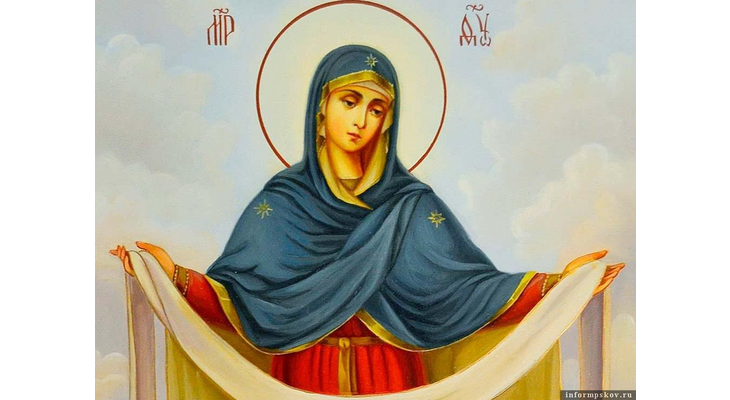Date according to the old calendar: October 1. On this day, Orthodox Christians celebrate a great feast — the Feast of the Protection of the Most Holy Theotokos. It is based on the tradition of the appearance of the Mother of God in a church in Constantinople, where her robe and part of her belt were kept, in the 10th century. According to the tradition, during the reign of Emperor Leo the Wise, the Byzantine Empire was at war with the Saracens. The Muslims had already approached close to Constantinople, and the capital was in danger. On Sunday, October 1 (according to the old calendar), during an all-night vigil, when the church was filled with worshipers, Saint Andrew the Fool for Christ looked up to the sky and saw the Mother of God walking through the air, illuminated by heavenly light and surrounded by angels and saints. For an entire hour, the Mother of God prayed, weeping. Afterward, she took off her shining veil and spread it over the people. When the vision disappeared, the veil became invisible, but the grace of the Mother of God remained with the people of Constantinople.
By the time of the Feast of the Protection, peasants would try to finish all agricultural tasks — gather the harvest and prepare supplies for the winter. The “zazimie” (the onset of winter) began. Livestock were no longer taken to pasture but kept in barns and switched to winter feed. On this day, workers were usually hired — typically until Epiphany. The Feast of the Protection was also considered a day for settling payments — for work and goods. In villages, weddings began on this day, and unmarried girls prayed to be betrothed to their beloved soon. "Cover the earth with snow, and me with a husband," they would ask the Mother of God. Another version of the request was: "Cover my poor head with a pearl kokoshnik, a golden headband."
The girls tried to celebrate the holiday as joyfully as possible, believing: "If you spend the Feast of the Protection happily, you'll find a dear friend." The first clean white snow was associated with a bride’s veil, and the amount of snow on the Feast of the Protection was believed to predict the number of weddings that would be held.
The Feast of the Protection was always considered an important holiday by the people, so on this day the whole family would go to church to pray to the Most Holy Theotokos and ask for her blessing. By this time, the season of village dances and outdoor games ended, and the evening gatherings began: girls would gather in a house in the evenings and do handicrafts, accompanied by singing.
Various signs were used to predict the weather. If the wind blew from the east, a cold winter was expected. If no snow had fallen by the Feast of the Protection, it meant it would not fall for a long time. However, this was rare. Russians used to say: "Before noon on the Feast of the Protection, it’s autumn; after noon, it’s winter."
Names celebrating their name day on this day: Alexander, Alexei, Vera, George, Ivan, Michael, Nicholas, Peter, Roman, Savva.









